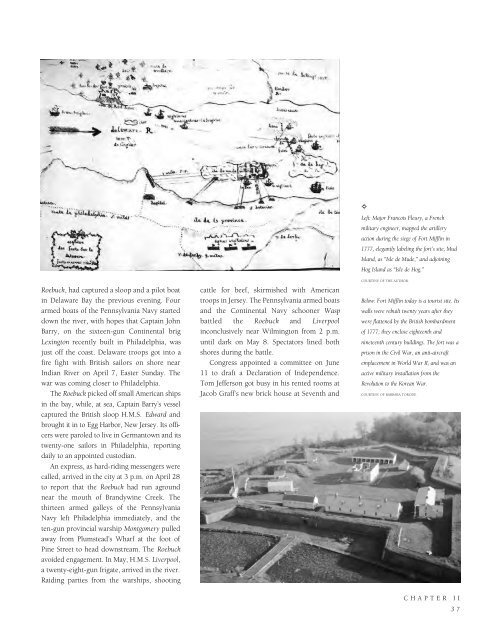Historic Philadelphia
An illustrated history of the city of Philadelphia, paired with the histories of companies, families and organizations that make the region great.
An illustrated history of the city of Philadelphia, paired with the histories of companies, families and organizations that make the region great.
You also want an ePaper? Increase the reach of your titles
YUMPU automatically turns print PDFs into web optimized ePapers that Google loves.
Roebuck, had captured a sloop and a pilot boat<br />
in Delaware Bay the previous evening. Four<br />
armed boats of the Pennsylvania Navy started<br />
down the river, with hopes that Captain John<br />
Barry, on the sixteen-gun Continental brig<br />
Lexington recently built in <strong>Philadelphia</strong>, was<br />
just off the coast. Delaware troops got into a<br />
fire fight with British sailors on shore near<br />
Indian River on April 7, Easter Sunday. The<br />
war was coming closer to <strong>Philadelphia</strong>.<br />
The Roebuck picked off small American ships<br />
in the bay, while, at sea, Captain Barry’s vessel<br />
captured the British sloop H.M.S. Edward and<br />
brought it in to Egg Harbor, New Jersey. Its officers<br />
were paroled to live in Germantown and its<br />
twenty-one sailors in <strong>Philadelphia</strong>, reporting<br />
daily to an appointed custodian.<br />
An express, as hard-riding messengers were<br />
called, arrived in the city at 3 p.m. on April 28<br />
to report that the Roebuck had run aground<br />
near the mouth of Brandywine Creek. The<br />
thirteen armed galleys of the Pennsylvania<br />
Navy left <strong>Philadelphia</strong> immediately, and the<br />
ten-gun provincial warship Montgomery pulled<br />
away from Plumstead’s Wharf at the foot of<br />
Pine Street to head downstream. The Roebuck<br />
avoided engagement. In May, H.M.S. Liverpool,<br />
a twenty-eight-gun frigate, arrived in the river.<br />
Raiding parties from the warships, shooting<br />
cattle for beef, skirmished with American<br />
troops in Jersey. The Pennsylvania armed boats<br />
and the Continental Navy schooner Wasp<br />
battled the Roebuck and Liverpool<br />
inconclusively near Wilmington from 2 p.m.<br />
until dark on May 8. Spectators lined both<br />
shores during the battle.<br />
Congress appointed a committee on June<br />
11 to draft a Declaration of Independence.<br />
Tom Jefferson got busy in his rented rooms at<br />
Jacob Graff’s new brick house at Seventh and<br />
✧<br />
Left: Major Francois Fleury, a French<br />
military engineer, mapped the artillery<br />
action during the siege of Fort Mifflin in<br />
1777, elegantly labeling the fort’s site, Mud<br />
Island, as “Isle de Mude,” and adjoining<br />
Hog Island as “Isle de Hog.”<br />
COURTESY OF THE AUTHOR.<br />
Below: Fort Mifflin today is a tourist site. Its<br />
walls were rebuilt twenty years after they<br />
were flattened by the British bombardment<br />
of 1777; they enclose eighteenth and<br />
nineteenth century buildings. The fort was a<br />
prison in the Civil War, an anti-aircraft<br />
emplacement in World War II, and was an<br />
active military installation from the<br />
Revolution to the Korean War.<br />
COURTESY OF BARBARA TORODE.<br />
CHAPTER II<br />
37
















